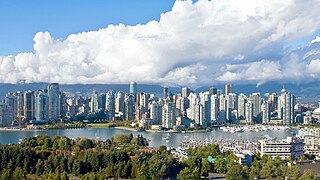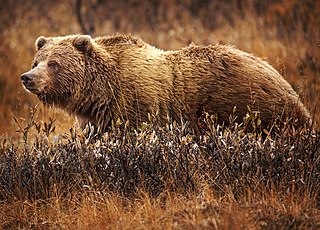
The American black bear, or simply black bear, is a species of medium-sized bear endemic to North America. It is the continent's smallest and most widely distributed bear species. It is an omnivore, with a diet varying greatly depending on season and location. It typically lives in largely forested areas but will leave forests in search of food and is sometimes attracted to human communities due to the immediate availability of food.

Haida Gwaii, also known as the Queen Charlotte Islands, is an archipelago located between 55–125 km (34–78 mi) off the northern Pacific coast in the Canadian province of British Columbia. The islands are separated from the mainland to the east by the shallow Hecate Strait. Queen Charlotte Sound lies to the south, with Vancouver Island beyond. To the north, the disputed Dixon Entrance separates Haida Gwaii from the Alexander Archipelago in the U.S. state of Alaska.

Graham Island is the largest island in the Haida Gwaii archipelago, lying off the mainland coast of British Columbia, Canada. It is separated by the narrow Skidegate Channel from the other principal island of the group to the south, Moresby Island. It has a population of 3,858, an area of 6,361 km2 (2,456 sq mi), and is the 101st largest island in the world and Canada's 22nd largest island.

The Sitka deer or Sitka black-tailed deer is a subspecies of mule deer, similar to the Columbian black-tailed subspecies. Their name originates from Sitka, Alaska, and it is not to be confused with the similarly named sika deer. Weighing in on average between 48 and 90 kg, Sitka deer are characteristically smaller than other subspecies of mule deer. Reddish-brown in the summer, their coats darken to a gray-brown in mid- to late August. They are also good swimmers, and can occasionally be seen crossing deep channels between islands. Their average lifespan is about 10 years, but a few are known to have attained an age of 15.

Gwaii Haanas National Park Reserve, National Marine Conservation Area, and Haida Heritage Site, usually referred to simply as Gwaii Haanas, is located in southernmost Haida Gwaii, 130 kilometres off the mainland of British Columbia, Canada. Gwaii Haanas protects an archipelago of 138 islands, the largest being Moresby Island and the southernmost being Kunghit Island. "Gwaii Haanas" means "Islands of Beauty" in X̱aayda kíl, a southern dialect of the Haida language.

Spirit of Haida Gwaii is a sculpture by British Columbia Haida artist Bill Reid (1920–1998). There are three versions of it: the black canoe, the jade canoe, and a full-sized plaster original. The black canoe features on Canadian $20 bills of the Canadian Journey series issued between 2004 and 2012.

The British Columbia Coast, popularly referred to as the BC Coast or simply the Coast, is a geographic region of the Canadian province of British Columbia. As the entire western continental coastline of Canada along the Pacific Ocean is in the province, it is synonymous with being the West Coast of Canada.

Skidegate is a Haida community in Haida Gwaii in British Columbia, Canada. It is on the southeast coast of Graham Island, the largest island in the archipelago, and is approximately 50 kilometres (31 mi) west of mainland British Columbia across Hecate Strait.

Daajing Giids, known as Queen Charlotte City from 1891–2022, is a village municipality in the Haida Gwaii archipelago in the province of British Columbia, Canada. It is located on the southern end of Graham Island at Skidegate Inlet and is a member municipality of the North Coast Regional District.

The Dawson's caribou, also known as the Queen Charlotte Islands caribou was a population of woodland caribou that once lived on Graham Island, the largest of the islands within the Haida Gwaii archipelago, located off the coast of British Columbia, Canada.
The Queen Charlottes Gold Rush was a gold rush in southern Haida Gwaii of what is now the North Coast of British Columbia, Canada, in 1851.

The Colony of the Queen Charlotte Islands was a British colony constituting the archipelago of the same name from 1853 to 1858, when it was amalgamated into the Colony of British Columbia. In 2010, the archipelago was renamed Haida Gwaii.

Mount Moresby is the highest mountain of the Queen Charlotte Mountains, located 26 km (16 mi) south of Daajing Giids on Moresby Island in British Columbia, Canada.

Skedans is a historic Haida village located on Louise Island at the head of Cumshewa Inlet in Haida Gwaii, British Columbia, Canada.

SG̱ang Gwaay Llnagaay, commonly known by its English name Ninstints, is a village site of the Haida people and part of the Gwaii Haanas National Park Reserve and Haida Heritage Site on Haida Gwaii on the North Coast of British Columbia, Canada.

The grizzly bear, also known as the North American brown bear or simply grizzly, is a population or subspecies of the brown bear inhabiting North America.
The 2012 Haida Gwaii earthquake occurred just after . The shock had a moment magnitude of 7.8 and a maximum Mercalli Intensity of V (Moderate). The earthquake's epicentre was on Moresby Island of the Haida Gwaii archipelago. This was the second largest Canadian earthquake ever recorded by a seismometer, after the 1949 Queen Charlotte Islands earthquake, about 135 kilometres (84 mi) away. One person died due to a car crash related to the tsunami in Oahu, Hawaii.

Tanu is a traditional Haida village site located on Tanu Island, Haida Gwaii, opposite of Kung'a Island in Laskeek Bay, within the Gwaii Haanas National Park Reserve and Haida Heritage Site.

The Council of the Haida Nation is the elected government of the Haida Nation, the Indigenous occupants of the Haida Gwaii archipelago in the Canadian province of British Columbia. The council consists of a president and vice-president elected by popular vote, twelve regional representatives from four electoral regions, and one appointed representative from each of the Old Massett Village Council and Skidegate Band Council.
Duu Guusd Heritage Site/Conservancy is a heritage site and conservancy located in the northwest corner of Graham Island in the Haida Gwaii archipelago of British Columbia, Canada. It was established on March 23, 2008 to protect the ecological integrity and cultural importance of the region. The conservancy is part of an archipelago-wide system of protected areas that includes Gwaii Haanas National Park Reserve and Haida Heritage Site, Gwaii Haanas National Marine Conservation Area Reserve and Haida Heritage Site, and 17 other provincially protected areas.



















